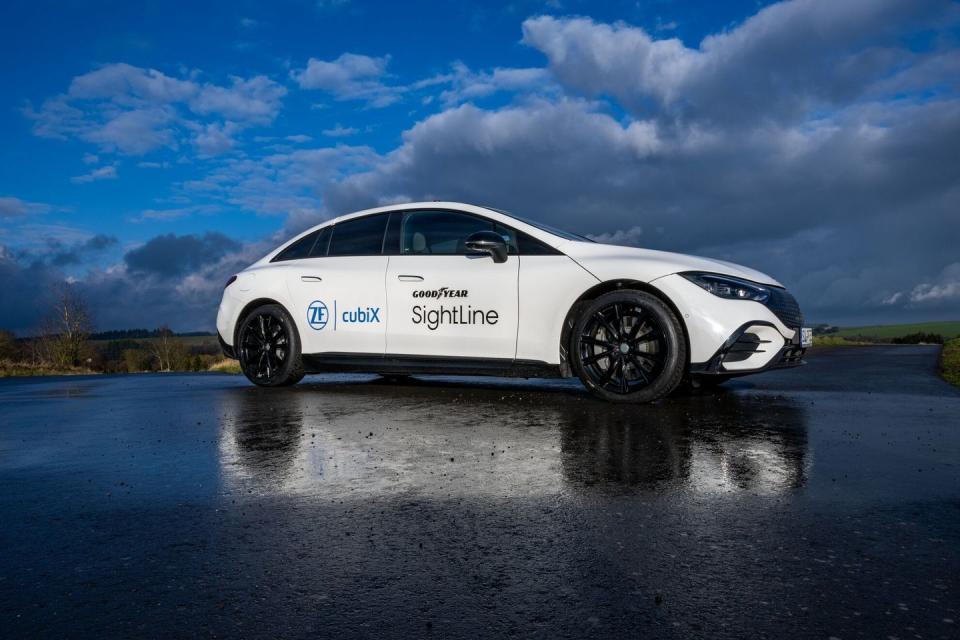Goodyear Moves for Safer Roads with Intelligent Tires

Tire technology continues to improve, with extended EV range and better longevity, but what if we could have electronically connected smart tires?
Goodyear is answering that hypothetical question with help from the folks at ZF, Gatik, and TDK, in an initiative it calls the Goodyear SightLine.
From improving ABS stopping distances and monitoring autonomous trucks to detecting and reacting to hydroplaning, Goodyear is banking on tire intelligence.
As the snow piles up outside our windows, we can hear the folks from Tire Rack and rubber brands across the world screaming out about the importance of tires. All-wheel drive certainly helps, but a proper set of winter tires will get you much further and keep you safer, too.
That same ethos applies to any rubber on the road even on a nice day, but Goodyear wants to improve roadway safety beyond proper tread depth and tire age. The tire manufacturer is working on an array of electronic sensors and systems known as tire intelligence, going far beyond your typical tire-pressure monitoring system.
Locally known as Goodyear SightLine, Goodyear's new electronic safety mission was announced at the 2024 Consumer Electronics Show last week in Las Vegas, but the Ohio-based rubber manufacturer is not going at it alone.
At the top of Goodyear's extensive testing list is researching how to reduce stopping distances. Enlisting the help of the Netherlands Organization (TNO) for Applied Scientific Research, the 126-year-old tire brand says tailoring antilock brake systems to the type of tire at hand could actually make a drastic difference.
Equipped with real-time information about tire compound, wear state, and road condition, ABS modules could delineate traction slippage even more precisely, reducing stopping distances by a claimed 5.75 feet.
That may not seem like much, but with 1.7 million rear-end crashes a year in the US, the National Highway Traffic Safety Administration says every foot counts.
"Our collaboration with Goodyear aims to minimize every centimeter of braking distance," said Machteld de Kroon, managing director of Unit Mobility & Built Environment, TNO. "We firmly believe that by improving the integration of tires and braking systems, we can contribute to reducing accidents and ultimately saving lives."
The concept of intelligent tires and modern braking systems being intertwined isn't all that surprising, but these announcements did come at CES, after all. An event that rewards truly out-of-the-box thinking and promises, Goodyear was clearly eager to get in the mix itself, too.
Also, keep in mind that rival tire producers, including Continental, have been talking about intelligent tires and their many attributes for more than 20 years. They haven't found popular acceptance because the technology is expensive.
Now, Goodyear is partnering with artificial intelligence companies like Gatik, electronics part producers such as TDK, and automotive engineering brands like ZF, to test a variety of, well, more out-there tire intelligence.

For starters, the tire company says monitoring impending autonomous vehicles should be done through their tires. Working with Gatik, Goodyear is implementing a series of tire intelligence solutions through its Goodyear Endurance RSA tires.
Mounted on a fleet of autonomous Class 3–7 box trucks, Gatik and Goodyear will monitor parameters like road conditions, rolling resistance, cornering accuracy, braking stiffness, and overall tire load.
"The real-time data derived from intelligent tire technology not only enhances the safety and predictability of our autonomous vehicles but also enables us to maintain high levels of efficiency, reliability, and delivery uptime throughout our operations," said Gautam Narang, Gatik CEO and co-founder.
In turn, both parties will save time, as vehicle conditions can be monitored remotely without pausing deliveries. Plus, Gatik can dynamically adjust loads on autonomous trucks to better suit the road or shifting weather conditions. Testing of this technology is under way at Goodyear's San Angelo, Texas, proving grounds.
Autonomous vehicle testing is interesting enough, but what about a safety feature that could keep everyday drivers safe? Goodyear says it has that covered as well, with some help from major Tier 1 German supplier ZF.

Pairing Goodyear's SightLine technology with ZF's cubiX vehicle motion control software, you may not have to worry about hydroplaning in the future. That's because the combined software will detect (courtesy of Goodyear) the impending puddle and then react (courtesy of ZF) to the potential loss of traction without much input from the driver.
However, the synergy between the two systems goes beyond slippery surface detection. Allegedly, these two electronic boxes will help drivers with enhanced vehicle responsiveness, more direct and linear steering, improved turn-in response, increased stability, and minimized intrusive interventions.
But how exactly do all these sensors come together? That answer comes from the TDK Corporation, a Japanese electronics producer helping Goodyear in its tire intelligence journey. In short, TDK will provide software, sensors, and electronic components for Goodyear's future smart tires.
Beyond these claimed groundbreaking capabilities, there is another benefit to the adoption of intelligent tires, Goodyear says. By collecting data about tire health and driving, manufacturers and drivers can better understand how vehicles wear tires and react to dynamic conditions. After all, tires might be the most important consumable on your car.
Do you switch your tires out seasonally? Why or why not? Please share your thoughts below.

 Yahoo Autos
Yahoo Autos 